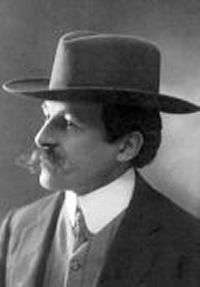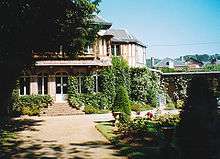Maurice Leblanc
| Maurice Leblanc | |
|---|---|
 | |
| Born |
11 November 1864 Rouen, France |
| Died |
6 November 1941 (aged 76)[1] Perpignan, France |
| Nationality | France |
Maurice Marie Émile Leblanc (/ləˈblɑːn/; French: [ləblɑ̃]; 11 November 1864 – 6 November 1941) was a French novelist and writer of short stories, known primarily as the creator of the fictional gentleman thief and detective Arsène Lupin, often described as a French counterpart to Arthur Conan Doyle's creation Sherlock Holmes.[2]
Biography
Leblanc was born in Rouen, Normandy, where he was educated at Lycée Pierre-Corneille.[3] After studying in several countries and dropping out of law school, he settled in Paris and began to write fiction, both short crime stories and longer novels. The latter, heavily influenced by writers like Gustave Flaubert and Guy de Maupassant, were critically admired but had little commercial success.
Leblanc was largely considered little more than a writer of short stories for various French periodicals until the first Arsène Lupin story appeared in a series of short stories that was serialized in the magazine Je sais tout, starting in No. 6, dated 15 July 1905. Clearly created at editorial request under the influence of and in reaction to the wildly successful Sherlock Holmes stories, the roguish and glamorous Lupin was a surprise success and Leblanc's fame and fortune beckoned. In total, Leblanc went on to write 21 Lupin novels or collections of short stories.
The character of Lupin might have been based by Leblanc on French anarchist Marius Jacob, whose trial made headlines in March 1905. It is also possible that Leblanc had also read Octave Mirbeau's Les 21 jours d'un neurasthénique (1901), which features a gentleman thief named Arthur Lebeau, and he had seen Mirbeau's comedy Scrupules (1902), whose main character is a gentleman thief.

By 1907, Leblanc had graduated to writing full-length Lupin novels, and the reviews and sales were so good that Leblanc effectively dedicated the rest of his career to working on the Lupin stories. Like Conan Doyle, who often appeared embarrassed or hindered by the success of Sherlock Holmes and seemed to regard his success in the field of crime fiction as a detraction from his more "respectable" literary ambitions, Leblanc also appeared to have resented Lupin's success. Several times, he tried to create other characters, such as private eye Jim Barnett, but he eventually merged them with Lupin. He continued to pen Lupin tales well into the 1930s.
Leblanc also wrote two notable science fiction novels: Les Trois Yeux (1919), in which a scientist makes televisual contact with three-eyed Venusians, and Le Formidable Evènement (1920), in which an earthquake creates a new landmass between England and France.
Leblanc was awarded the Légion d'Honneur for his services to literature, and died in Perpignan in 1941. He was buried in the Montparnasse Cemetery. Georgette Leblanc was his sister.
Influences
The character Arsène Lupin III, protagonist of the Japanese manga Lupin III beginning in 1967, was written as the grandson of Arsène Lupin but without permission from Leblanc's estate. That was later the source of a lawsuit though the copyright on Leblanc's work has since expired. When the anime version was broadcast in France, the character was renamed Edgar, le détective cambrioleur ("Edgar, the Burglar Detective"). The authors of the various Lupin III properties drew on Leblanc's novels as inspiration; notably, the film The Castle of Cagliostro was loosely based on La Comtesse de Cagliostro (The Countess of Cagliostro).
Selected bibliography
- Une femme (1893)
- Armelle et Claude (1897)
- Voici des ailes (1898)
- Les Lèvres jointes (1899)
- L’Enthousiasme (1901)
- Un vilain couple (1901)
- Gueule rouge (1904)
- 80 chevaux (1904)
- La Pitié, Play (1906)
- L’Aiguille creuse ("The Hollow Needle") (1909)
- 813 (1910)
- La Frontière ("The Frontier")(1911)
- Les Trois Yeux ("The Three Eyes") (1919)
- La Robe d’écaille rose (1920)
- Le Formidable Événement ("The Tremendous Event") (1920)
- Le Cercle rouge (1922)
- Dorothée, danseuse de corde (US: "The Secret Tomb", UK: "Dorothy the Rope Dancer") (1922)
- La Vie extravagante de Balthazar (1925)
- Le Prince de Jéricho ("Man of Mystery") (1930)
- Les Clefs mystérieuses (1932)
- La Forêt des aventures (1933)
- Le Chapelet rouge (1934)
- L’Image de la femme nue ("Wanton Venus") (1934)
- Le Scandale du gazon bleu (1935)
- De minuit à sept heures ("From Midnight to Morning") (1937)
References
- ↑ Staff writer (7 November 1941). "Maurice LeBlanc Dies at 77; Creator of 'Arsene Lupin'". St. Louis Post-Dispatch. 94 (63). St. Louis, Missouri. p. 3 – via Newspapers.com.
- ↑ Mordaunt Hall (1932). "Arsene Lupin". The New York Times.
- ↑ Lycée Pierre Corneille de Rouen – History
External links
| Wikisource has original works written by or about: Maurice Leblanc |
- Works by Maurice Leblanc at Project Gutenberg
- Works by Maurice Leblanc at Faded Page (Canada)
- Works by or about Maurice Leblanc at Internet Archive
- Works by Maurice Leblanc at LibriVox (public domain audiobooks)

- Le Clos Arsène Lupin, Maison Maurice Leblanc (museum)